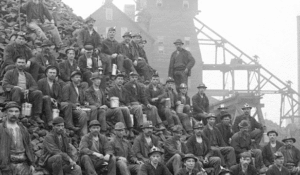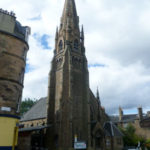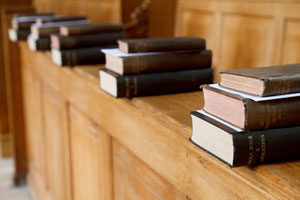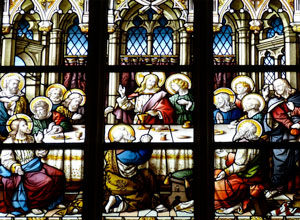In 1979, David Edwards in Glasgow sent a questionnaire to churches, an early initiative by the (still flourishing) Scottish Baptist History Project. He asked 64 questions about ‘the life of the churches in the (inter-war) years from 1918 to 1939’. I was given twelve completed questionnaires while preparing a chapter for the 1988 monograph, David Bebbington (ed.), Baptists in Scotland: a History. I came across them during a recent spring-clean and thought it worth preparing this Paper.
Contents
1. Ayr
2. Cambuslang
3. Clydebank
4. Edinburgh: Marshall Street
5. Edinburgh: Morningside
6. Glasgow: Harper Memorial
7. Glasgow: Partick
8. Glasgow: Queen’s Park
9. Fife: Leslie
10. New Prestwick
11. Paisley: George Street
12. Rutherglen
13. Sunday: Overview of the two services
14. Sunday morning service
15. Sunday evening service
16. Sunday school
17. Other Sunday activities
18. Weekdays
19. Evangelism
20. Other activities inside the church building
21. Other activities outside the church building
The twelve responding churches, with details added from George Yuill’s 1926 History of the Baptists in Scotland, were:
| Church | Founded | 1926 Building from | Founding members | Membership in 1926 | Origin |
|---|---|---|---|---|---|
| Ayr | 1886 | 1887 | 20 | 124 | Home Mission extension |
| Cambuslang | 1880 | 1895 | Few | – | Local Baptists initiative |
| Clydebank | 1889 | 1894 | – | – | Local Baptists initiative |
| Edinburgh – Marshall Street [1] | 1846 | 1877 | 21 | 100+ | Edinburgh minister’s initiative |
| Edinburgh – Morningside [2] | 1894 | 1894 | 19 | – | A Leith minister’s initiative |
| Glasgow – Harper Memorial | 1897 | 1921 | 25 | 483 | Layman – John Harper – died Titanic |
| Glasgow – Partick | 1899 | 1912 | 18 | 400 | Extension from Hillhead |
| Glasgow – Queen’s Park | 1878 | 1887 | – | 370 | Extension from Adelaide Place |
| Leslie, Fife | 1880 | 1886 | 33 | 62 | One local family’s enthusiasm |
| New Prestwick | 1889 | 1900 | Few | – | Member of Ayr who lived in New P. |
| Paisley – George Street [3] | 1842 | 1861 | – | 142 | Split doctrinally from Storie St. |
| Rutherglen | 1893 | 1904 | Few | – | Local Baptists getting together |
Second left on the Note, the year of constitution, all mid to late 19th century, a time of vigorous Baptist evangelism and church extension in Scotland.
The third column, when the building in which they worshipped in 1926, the year of Yuill’s history, was opened. Let me expand on that:
Back to top
Ayr
Prior to 1886, the date on the Note, a Baptist church met in the Black Bull Inn – a curious choice of venue – for thirteen years from 1837 and candidates were baptised in the River Ayr. There was then a gap of 36 years, and the present church was formed in 1886 with 20 members. They met in the Free Gardeners’ Hall, then the Liberal Hall and then the Ayr Theatre, which they bought in 1887 – one year after constitution. Ayr is the only church to mention the purchase of a manse, which they bought in 1922.
- Covers only 1921-28.
- The respondent from Morningside was aged eleven in 1939, but based his answers only on his own memories and didn’t consult older members.
- The respondent from George Street consulted a member who had been 60 in 1919 and so 80 in 1939.
Cambuslang
 Cambuslang was one of only four churches to give Yuill information about their community. When the church was founded in 1880, the village was for coal miners and quarry workers. They hired a hall in the main street in 1880 and ‘through the unremitting zeal of the pastor’ built a ‘handsome church and halls’ fifteen years later. By 1926 Cambuslang had become a commuter town for Glasgow, although it still had steelworks and other industries – membership of the church in 1926 is not given.
Cambuslang was one of only four churches to give Yuill information about their community. When the church was founded in 1880, the village was for coal miners and quarry workers. They hired a hall in the main street in 1880 and ‘through the unremitting zeal of the pastor’ built a ‘handsome church and halls’ fifteen years later. By 1926 Cambuslang had become a commuter town for Glasgow, although it still had steelworks and other industries – membership of the church in 1926 is not given.
Clydebank
Clydebank was working class and industrial, both in 1889 and 1926. The church first met in 1889 in the Committee Room of the Public Hall, Three years later, while using another public hall, they resolved to build a church seating 250 and a hall for 110, which opened in 1894.
Edinburgh – Marshall Street
The church which became Marshall Street in Edinburgh rented a hall during its first year, then a school hall for another year, then a public hall seating 600 for eight years, after which they used Richmond Hall for 21 years. Thirty-one years after starting, they purpose-built in Marshall Street, near the then Royal Infirmary.
 Edinburgh Morningside
Edinburgh Morningside
Edinburgh Morningside is the only one of the twelve to purchase a building before constituting a church. In April 1894, the Morningside Free Church at Holy Corner came on the market. Local Baptists bought it, with a large mortgage, and set about forming a church to occupy it, which they did nine months later.
Back to top
Glasgow – Harper Memorial
Harper Memorial was in a densely populated district adjoining the Glasgow docks, where the majority worked as quay labourers. John Harper, a local factory worker, gathered 25 men and women in 1897 to form the Paisley Road Baptist Church, and he became their full-time pastor. Four years later they expanded the building, to seat 550, and four years later enlarged it again to seat 800. John Harper went down with the Titanic in 1912, and nine years later the congregation opened a new building and named it Harper Memorial.
Glasgow – Partick
A Mission hall in Partick in Glasgow become a Baptist church in 1899, after 18 members of the Hillhead Baptist Church transferred to help the work there. The Glasgow Baptist Association funded new halls in 1909, which were expanded in 1912. When they contributed to Yuill’s book in 1926, the 400 members were raising funds to build a new church.
Glasgow – Queen’s Park
Queen’s Park. In 1878, four members of the Adelaide Place Church in Glasgow rented a brick building in the rapidly growing suburb of Queen’s Park, and a few months later constituted a church, which, a your later, had 64 members. The hall was ‘comfortless and without a baptistery’, so seven months later they bought a larger hall, which served them for eight years. The church which they built in 1887, the year in the Note, was enhanced in 1924 by a pipe organ – more about that later.
Back to top
Leslie, Fife
The Leslie church met in the Town Hall for six years and then the brother of the pastor acted as architect and clerk of works and opened their own building, free of debt, in 1886.
New Prestwick
New Prestwick was the initiative of a member of the Ayr church who lived in New Prestwick, and who in 1889 built a wooden hut for Sunday and weeknight services. Eleven years later, the members funded a ‘proper’ church. I said earlier that only Ayr mentioned buying a manse, but in 1917 a member of New Prestwick bequeathed her house to the church and they gratefully used it as the manse.
Paisley – George Street
Paisley George Street met in a local school after leaving the Storie Street Church on a doctrinal issue, and then occupied a former Methodist Chapel in George Street until they built their own church 19 years after the division. In 1911 the church was renovated, new halls were added and a pipe organ installed.
Back to top
Rutherglen
Rutherglen met initially in the Lesser Town Hall, then bought a site six years later and three years after that took possession of a new 400-seater church. By 1926, Rutherglen was largely a dormitory for Glasgow business people, although local industries included chemical, steel, jute and coal mines.
So by 1918, when our study starts, all the churches except Partick had as much accommodation as they needed for their work.
Next column, the number of members at the foundation of the church and the membership in 1926; in the last column, a brief note on how churches were started – eight of them through local initiative.
I’ve grouped the answers to the sixty-four questions into four headings:
1. Sunday, subdivided into an overview, the morning service, the evening service, Sunday School and
other Sunday activities.
2. Weekdays
3. Evangelism
4. Other activities, subdivided into Inside and Outside the church building.
There was only one narrow line in the questionnaire for both the question and the answer to it. So, for example, to the question ‘Was there a choir?’, most responded simply ‘yes’. Cambuslang managed to squeeze into the space that they had a Church choir, a Male Voice choir and also Senior and Junior choirs. That makes one wonder whether we’re getting the full picture from other churches in some areas.
There were a number of blanks in the answers. Rather than say in this Paper, ‘no answer from x churches for this section’, I’ve not mentioned the blanks, so the totals will not add up to twelve in many of the sections. One of the answers was thoughtlessly unhelpful; asked how things were done between 1918 and 1939, one church answered ‘much as today’, which is no help unless one knows what was happening in that church about 1965.
I’ve added some comparisons with Charlotte Chapel in Edinburgh, with the Church of Scotland and with the Christian Brethren. These are my glosses – none of these were mentioned in the questionnaires.
The ‘Sunday’ section is by far the longest part of this Paper, well over a half of it.
First, an overview of areas common to both Sunday services.
Back to top
 SUNDAY – OVERVIEW OF THE TWO SERVICES
SUNDAY – OVERVIEW OF THE TWO SERVICES
Services
All twelve had two services on Sunday, nine at 11 am, two at 11.15, and at Clydebank it was 12 noon, preceded by Christian Endeavour at 11. All twelve started their evening service at 6.30.
At six of the churches, the morning service was the better attended; at four it was the evening service, and at Clydebank both were ‘equally good’. Only two gave numbers; Harper Memorial, whose membership in 1926 was 483, had 300 in the morning and 600 in the evening; Leslie, whose membership that year was 62, had 80 in the evening, and that was the better attended.
How the two services differed will best be explored when we look at the services separately, but the overall picture is of more participation in the evening, with testimonies and solo-singing and more choir involvement.
Non-members attending
‘Did many non-members attend church?’ We’ll come, later, to a question about evangelistic outreach, but this was a general question, which didn’t differentiate between morning and evening services; since the answers were largely monosyllabic, it may be that they applied to both. Seven of the responses were ‘yes’, that is, non-members attended; two said ‘a few’, and one said ‘no’. Only Partick said ‘quite a number’.
Organ and choir
All twelve churches had an organ, and all had a choir, although in three churches the choir sang only at the evening service. As mentioned, Cambuslang had a Church choir, a Male Voice choir and also Senior and Junior choirs; Clydebank had both Senior and Junior choirs.
 Flowers
Flowers
All twelve churches were decorated with flowers on Sunday; from the replies, ‘yes, always’, ‘every Sunday’ and ‘provided by individual members’, it seems that flowers were appreciated and expected.
The impact of War
Questioned about changes because of the First World War, there was little comment, apart from casualties among those on active service. Clydebank’s attendance suffered through men being required to work on Sundays during the war and membership at both Clydebank and Partick declined after the War, due to emigration to find work.
Asked the same question – were there any changes? – after War was declared on 3 September 1939, Morningside and Queen’s Park moved their evening service to the church hall, as more suitable to black-out for air raid precautions, but the only other comments were about the number of men away on military service. Ayr started a canteen for servicemen in the church hall.
Special pews
Only Marshall Street in Edinburgh still charged Pew Rent, but four others replied ‘yes’ to the question, ‘Are there “special pews’? Whether that meant that office-bearers or families had reserved seats, we’re not told, but over those years in Charlotte Chapel in Edinburgh, the elders (without their wives or families) exclusively occupied reserved seats on the two front pews which faced the sides of the pulpit. When, in the early 1950s, I asked why this was so, I was told it was symbolic, to show the elders visible support and encouraged for the preacher in the pulpit.
Intimations
The answers to the question, ‘What did the intimations include?’ may seem to those now accustomed to a printed bulletin to be lengthy and laboured. Before I analyse the answers, may I comment on the Sunday intimations at the Portobello Baptist Church, Edinburgh, which I attended for a while when William Whyte was the minister. Although Mr Whyte was sitting in the pulpit, the Secretary intoned, every Sunday morning and evening, ‘The preacher at the service this evening / next Sunday will be the Reverend William Whyte, M.A.’ Surely ‘our pastor’ would have sufficed.
The responses to the questions about intimations were, predictably, ‘the services and events during the week’, ‘the times of future Sunday services’, ‘the prayer meeting and other weekly activities’, and ‘missionary meetings’; intimations about ‘denominational activities’ was threefold, (1) ‘local’ (presumably events in nearby Baptist churches), (2) ‘regional’ (that is, Associations) and (3) Baptist Union of Scotland – presumably mainly about the annual Assembly.
No one mentioned that the intimations concluded by announcing the offering – perhaps they didn’t, but I’ll come back to that when we look at Offerings in the next section.
Memorable services
Asked about ‘great services of the year’, most focused on the calendar, three said Christmas, four said the Watch night on Hogmanay, two said Easter and two said Harvest Thanksgiving; five also listed their own Anniversary Sunday, and six said that the Sunday School anniversary was a ‘great occasion’.
That question was followed by, ‘who came to the great services’? All but two said ‘members and adherents’. Harper Memorial added ‘many living in the district’, which is encouraging because they listed their ‘great services’ as ‘Sunday nearest Christmas, the Watch night service on 31 December and the Sunday nearest New Year’. If they got ‘many living in the district’ to come to these services, well done.
Two commented on their Anniversary. Partick said that many former members came to it – unusual, surely – and Queen’s Park said, ‘members and a number of visitors from other Baptist churches’; one wonders whether local churches sent people to honour the Queen’s Park Anniversary, or whether Queen’s Park invited outstanding guest preachers for their Anniversary and some from other churches played hookey and came to hear them? – I’m guessing.
No one mentioned ‘others’ at the Sunday School anniversaries, which may imply that the Sunday School scholars were from the homes of members; otherwise parents, or at least mothers, might have come to special Sunday School occasions.
Back to top
SUNDAY MORNING SERVICE
Hymnbook and hymns
Nine of the churches used the Baptist Church Hymnal in the morning, the 1907 edition until a revised edition came out in 1933. Individuals and churches could purchase copies with the Psalms and 67 Paraphrases printed after the hymns, and three of the churches said that they started the morning service with a Psalm or Paraphrase, followed by three or four hymns. Most of the other churches had four hymns in the morning, but the two Edinburgh churches had five.
Sermon
The morning sermon was between twenty and thirty minutes in four churches, half an hour in six others, forty minutes at New Prestwick and forty-five at Harper Memorial. The morning sermon was variously described as ‘Biblical Teaching’, ‘Ministry’, ‘Devotional’ or ‘Exposition of a text’; Clydebank described it as ‘Theological’. Clearly the morning sermon was, as the Cambuslang answer put it, ‘directed to church members’.
The Lord’s Prayer
Five regularly said the Prayer together, four others did so ‘sometimes’ and Partick ‘infrequently’; the choir sang the Lord’s Prayer at Marshall Street and Queen’s Park. That may explain the next question, ‘Did the congregation stand for hymns or prayer?’. Not surprisingly, all twelve congregations stood for the hymns, but the question may have been directed to the Lord’s Prayer, as in some other churches the congregation rise and say the words together. In none of our twelve did the congregation stand for the Lord’s Prayer and Cambuslang, where the Lord’s Prayer was used, specifically answered ‘not standing for the prayers’.
Benediction
Rutherglen said what was probably true for all, but no one else mentioned it – that the congregation remained standing, after the closing hymn, ‘for the benediction’. May I add a comment, not from the questionnaire; in many Christian Brethren services at the time, the congregation was invited to sit after the closing hymn, as the closing prayer was lengthy, far more than a benediction.
Offering
All twelve churches had an offering; presumably, because the word ‘offering’ was used, a bag came round during the service rather than a box or plate at the door. I wish the question had asked when in
the service the offering was uplifted, because in Baptist churches as far back as I can remember, it was before the sermon, often, as I mentioned earlier, the Church Secretary closed the intimations by announcing the offering, sometimes with a short prayer of dedication, whereas in the Church of Scotland, as I understand it, the offering was deliberately taken after the sermon, as the congregation’s response to the preaching of the Word.
Children in the morning service
All the churches except Ayr had a Children’s Address in the morning, but only at George Street in Paisley did the children then go out for the rest of the service.
 Communion
Communion
Communion was held every Sunday in eleven of the churches, but at Partick it was twice a month – in the morning on the first Sunday of the month and in the evening on the third Sunday. Queen’s Park changed from every Sunday to twice a month in 1937. At Clydebank it was in the morning except for the first Sunday in the month, when it was held in the evening.
Unbaptised believers were invited to take communion in five of the churches but not in five others. Clydebank said that ‘all Christians of any denomination were allowed’.
Harper Memorial volunteered a comment which is worth following up. Communion there was held every Sunday morning ‘after the service’, meaning, I presume, that there was a benediction and the opportunity to leave before those who remained took communion.
Was that was the general practice in Baptist churches at the time? In Charlotte Chapel at that time, there was not only an opportunity to leave between the benediction and the weekly Lord’s Supper, but those in the gallery came downstairs and filled the places of the many in the area of the church who had left; communion was served at only one level. Graham Scroggie was so concerned about the number who left that on the first Sunday of every quarter he celebrated communion before the sermon, with the elements served in both the area and the gallery. From his report to the elders, it’s clear that Scroggie’s motive was entirely spiritual, but it made the elders’ task easier because they were supposed to interview every member who had not attended communion for six months with a view to removing that person from membership.
A common cup was used until (going backward in dates) 1932 at Clydebank, 1930 at New Prestwick, 1929 at Partick, the late 1920’s at Ayr, 1920 at Cambuslang, 1918 at George Street, Paisley, ‘before 1914’ at Leslie’ and 1910 at Queen’s Park.
This is not from the questionnaires, but we know from elsewhere that the Scottish Baptist Individual-Cup Communion Association, formed in 1907, not only encouraged the practice but demonstrated it by holding a united communion service on the last Monday of every month, using individual cups.
An advertisement in the monthly Scottish Baptist Magazine from 1929 to 1935 read:
Danger at the Communion Table
‘Doctors and Public Health Officers pronounce the use of the Common Cup as liable to convey Infectious Diseases’
and urged readers to contact the Birmingham supplier of individual communion cups.
In 1935 they changed the heading from ‘Danger at’ to the more positive ‘Safety at’:
Safety at the Communion Table
but still said that ‘Doctors and Public Health Officers warned about Infectious Diseases.’
Back to top
SUNDAY EVENING SERVICE
Hymnbook and sermon
Five churches used Redemption Songs at the evening service and three others used Sankey’s Sacred Songs and Solos. That reflected the purpose and emphasis of the evening service, which the respondents described as ‘Gospel’ (three churches), ‘Evangelistic’ (six churches), ‘Directly Evangelistic’ at Cambuslang and ‘Exposition of a text with an evangelistic aspect’ (Queen’s Park).
The evening sermon was between twenty and thirty minutes in all the responding churches.
SUNDAY SCHOOL
Every church had a Sunday School in the afternoon, attended by, to quote the answers, ‘children of all ages’, ‘up to 16’, ‘6 to 15’, ‘5 to 16 or 18’. ‘3 to 14’, ‘up to 14’.
The next question seems curious – ‘Were choruses used’? Eight responded ‘yes’, three responded ‘no’ and Partick replied ‘never in church but sometimes in the Sunday School’. Rutherglen answered ‘yes’ but qualified it with ‘not on Sunday’; there must have been some issue at the time about singing choruses,
OTHER SUNDAY ACTIVITIES
As well as Sunday School, six of the churches had Bible Class on Sunday afternoon. Partick was specific – Sunday School – 2:30 – Bible Class – 4 pm – Senior Christian Endeavour – 8 pm’.
In addition to Sunday School and Bible Class, Rutherglen had a Sunday Young People’s Fellowship, and Ayr had a ‘Round Table’, and also a Gospel Outreach in the town during the winter months. I have fond recollections of evangelistic outdoor services on the Front at Ayr during summers in the early 1950s, but there’s no mention of that in the questionnaire – only their Sunday Gospel Outreach in the town during the winter months.
Still on Sunday activities, two mentioned Prayer Meetings; Harper Memorial had one at 7 a.m. every Sunday and Cambuslang held one before both services. Surely others had collective prayer sometime on Sundays – although they didn’t mention it?
Only Cambuslang mentioned ‘Members Meetings after church’ on Sunday. If there was business, such as applications for membership, it was no doubt convenient to ask members to remain for a short time after the benediction. It seems likely that other churches also did this, but only Cambuslang mentioned it. I (and no doubt some of you), when visiting a church by invitation, with hospitality offered, have been asked the hosts for lunch to wait in the church hall for a short while, as the members had business to deal with after the morning service.
Back to top
WEEKDAYS
Main weeknight service
In answer to the question, ‘What was the main weeknight service?’, all eleven who responded said ‘the Prayer Meeting’. Three mentioned it was on Wednesday. Harper Memorial added that occasionally on Friday they had an all-night prayer meeting.
The follow-on question was, how many came to this weeknight service, compared to Sunday? Three answered with a percentage, one third at Clydebank, 30% to 40% at Partick, and less than half at Marshall Street. Leslie gave both the number and the percentage, ‘up to 40’, which was 50% of the better-attended Sunday service. Cambuslang said ‘40 to 50’ and Harper Memorial ‘60 to 100’ – out of the 300 on Sunday morning at Harper and 600 on Sunday evening.
Did ladies ever pray?
This must mean audibly at mixed meetings, because there were separate women’s meetings, as we’ll see next. Women did pray at eight of the churches, but not at the other four. Of the eight, five said simply ‘yes’, while the other three said ‘not many’, ‘rarely’ and ‘very seldom’. It’s not in the questionnaire, but with our generation accustomed to address the deity as ‘you’, it’s worth remembering that until well after the Second World War, it was ‘thee’ and ‘thou’ in prayer.
On women praying audibly at mixed meetings, I was once at a meeting where, unexpectedly, a lady took part. On the way out, I overheard one of the men saying to the Minister, ‘Are you going to speak to that lady about what she did?’, to which the Minister replied, ‘No, I’m going to speak to the men about the long silences which prompted her to contribute.’
Women’s Meetings
Seven of the churches had a Women’s Auxiliary on a weeknight evening, and three of these also had a Women’s Own during the afternoon on a different day of the week. One had only a Women’s Own. Marshall Street had a Ladies Sewing Meeting in a home and Leslie had a Women’s Work Party on Thursday.
Sales of work
Nine said ‘yes’, and three said ‘no’. Queen’s Park held a big one in 1924 to raise money for the purchase of a pipe organ – they had had only a harmonium in the church until then – and they also had ‘other small efforts from time to time’.
Morningside in Edinburgh bought the vacant Free Church at Holy Corner for £3,000 in 1894 and held a bazaar every Spring and a Sale of Work every autumn to pay off the debt on the building. Partick were more guarded – ‘only for special purposes – very rarely’.
Youth meetings and Organisations
I’ve combined the answers to the question ‘Were there Youth Meetings?’ with the answers to the question ‘Organisations?’ because some put Christian Endeavour into one section, some into the other, and some into both.
All had some kind of Youth Meeting; six churches were linked with outside Organisations like Boys Brigade and Scouts.
Christian Endeavour was the most popular, held in eight of the churches, and some gave details of its Junior, Intermediate and Senior classes. The others, in alphabetical order, were:
- Band of Hope (three),
- Boys Brigade (two) [4],
- Brownies (one),
- Cubs (one),
- Friday evening Lantern Slide talk (winter months only) (one),
- Girls Auxiliary (three),
- Girl Guides (three),
- Lifeboys (one),
- Scouts (one),
- Young People’s Club, renamed Young People’s Fellowship in 1938 (two).
The Girls Auxiliary deserves a little more said about it, beyond the answers in the questionnaires. Weekly meetings encouraged girls between 10 and 16 to be part of the world-wide missionary movement, reading mission books, collecting missionary information and developing missionary zeal. There doesn’t seem to have been a parallel organization for boys.
- This is not from the questionnaires, but some churches would not have a Boys Brigade because they considered that after the horrors of the recent World War, uniforms and parades and marching encouraged boys to approve of ‘the military’ and, similarly, they disapproved of the Scout movement because of Baden-Powell’s military background.
Outings
Eleven of the churches had one or more outings, some implying that they were annual and some saying they were by bus or tram. Nine mentioned the Sunday School, which was the only outing for four churches. Other outings were for the Bible Class, the Choir, Christian Endeavour and the Women’s Auxiliary. Queen’s Park had separate outings for Brownies and Guides, Lifeboys and Boys’ Brigade, Band of Hope and their Girls’ Auxiliary.
Missionary Meetings
Ten churches had Missionary Meetings, and one did not. Six answered simply ‘yes’, and the other four said: ‘twice a year’, ‘frequently but not monthly’, ‘occasionally’ and for ‘specific projects for the Baptist Missionary Society’.
Business Meetings
Asked how frequently these were held, six said quarterly, two said half-yearly and two said annually. Partic held Business Meetings ‘when special business had to be discussed’.
Back to top
EVANGELISM
There were five questions under this heading – do you have open airs, tract distribution, posters, visitation and campaigns? Taking these in order:
On open-air evangelistic meetings, Ayr, Cambuslang, Harper Memorial, Partick, Queen’s Park and New Prestwick replied ‘yes’, but gave no details.
On tract distribution, five churches did, but whether this meant putting evangelistic literature through letterboxes or whether it meant making personal contact in the street or by knocking on doors, is not recorded.
Marshall Street, who answered ‘none’ to the questions about open airs and tract distribution, was one of only four who put up evangelistic posters outside the church.
Although the question about visitation was a subheading of Evangelism, all those responding seem to have treated it as a question about pastoral care rather than outreach. Morningside specifically said ‘only congregational’. Two others replied that the pastor did visitation, four that the deacons did, and another three that visits were to the infirm or elderly; Queen’s Park did it to encourage attendance at the Sunday School.
Only Partick ‘sometimes visited surrounding houses’ as well as visiting the sick. I have a particular affection for Partick, as one of my best student friends, Jim Taylor, later the minister of the Helensburgh, Ayr and Stirling churches, was student pastor at Partick and I spent many happy weekends with him there in our bachelor days.
Nine churches had evangelistic campaigns, although two qualified it with ‘periodically’ or ‘occasionally’; Queen’s Park mentioned specific campaigns in 1929, 1932 and 1937. Rutherglen’s Christian Endeavour had special weeks with CSSM students – Children’s Special Service Mission, now Scripture Union. Marshall Street held temperance campaigns.
Five mentioned other local initiatives – Clydebank and Harper Memorial had Saturday evening evangelistic tea meetings and Ayr, Cambuslang and New Prestwick held cottage or kitchen meetings.
Back to top
OTHER ACTIVITIES INSIDE THE CHURCH BUILDING
Magazines
Four churches produced their own Magazine, although one was ‘off and on’. Seven subscribed to the monthly Scottish Baptist Magazine and the Missionary Herald, which presumably means that a magazine secretary received them in bulk and distributed the copies. Two took only the Scottish Baptist Magazine; Harper Memorial mentioned only EUSA and The Christian, while Rutherglen mentioned only the Christian Herald and the Sunday Companion.
Translations of the Bible
Asked ‘Did people use any version besides the Authorised Version of the Bible?’, it’s clear that no other translation was used at public services, but six of the respondents had other translations for their personal use; one mentioned Weymouth (1903, New Tertament only), two mentioned Moffatt (1927, both Testaments), and three others didn’t say which. Another option would have been the Revised Version of 1881 for the New Testament and 1885 for the Old, but no one mentioned it.
Role of the deacons
Six said it was to serve at the Lord’s Table and to welcome at the door, four said it was to visit the members in their district, while others emphasised management – ‘to run the church’ as one put it. Only Partick said it was to uplift the offering.
Important offices in the church
The answers reflected different local situations; four listed the Secretary and the Treasurer, while two added the Minister to that duo, and one added the Sunday School Superintendent. Marshall Street said Minister and Secretary, not mentioning the Treasurer. Harper Memorial’s response was ‘Minister, Secretary, Deacons and the Missionary Convener’.
Events in the building
Asked if there was any recreation in the church, two responded ‘badminton’, one responded ‘tennis’, and seven said none. Asked about meals at church, all but one answered ‘no’ – presumably the others didn’t count soirees as ‘meals’. Asked about entertainment evenings, two mentioned ‘socials’ and ‘soirees’ (Leslie commenting that there used to be many more than today), one mentioned a Choir cantata and five replied ‘none’. The next question was similar, about Concerts; two mentioned the Choir and six said ‘none’.
Back to top
OTHER ACTIVITIES OUTSIDE THE CHURCH BUILDING
Other churches
Five churches held United services, Cambuslang during Holy Week; Marshall Street and Queen’s Park just said ‘yes’; George Street said ‘from time to time’, Leslie said ‘very occasionally’ and Partick said ‘rarely’. Three said ‘no’; overall, not much inter-church activity, but Rutherglen added that the local ministers met regularly.
Asked how often you (presumably personal to the respondent) would go to another church, five said ‘only when on holiday’, other replies were: ‘occasionally’, ’not often’ and ‘very rarely’; three said ‘never’.
Associations
Nine sent representatives to Association Meetings, naming their local Association. Eight attended Baptist Union of Scotland meetings; Leslie, who ‘always’ attended Association meetings, ‘never’ went to Union activities.
Smoking, drinking, football
To the question ‘Did many smoke? Marshall Street answered ‘most men’; Queen’s Park said ‘yes’ and George Street said ‘some’. Partick rather defensively said, ‘Several, but not in church’. Only Clydebank and Leslie answered ‘none’. The other seven said ‘no’, but that is ambiguous, because the question was ‘Did many smoke? Does ‘no’ mean that not many smoked, or does it mean none?
To the question ‘Did many drink’? Cambuslang, Clydebank and Leslie said ‘none’, Marshall Street ‘very few’ and George Street ‘a few’. The other eight said ‘no’, but, again, that may mean ‘not many’ or it may mean none.
‘Would members go to football matches?’ Five said ‘yes’, Cambuslang said ‘no’, other answers were ‘a few. ‘some’, and ‘many would not’.
Finally, ‘Was anything taboo, which we now accept, or vice-versa?’
This brings us to 1979, contrasting it with the inter-war years. The answers were:
Cinema (Ayr, Harper Memorial, Leslie)
Country-dancing by Girl Guildry (Cambuslang)
Dancing (Ayr, Marshall Street)
Informal minister’s dress (Partick). (? no clerical collar, no dark suit, no tie – they don’t say.)
Make-up, lipstick, nail varnish (Marshall Street, Leslie)
Whist-drives (Ayr)
Women of all ages not wearing hats (Clydebank, Leslie, New Prestwick)
Women’s Auxiliary Sales of Work (Cambuslang)
That’s the end of the 64 questions and answers. A snapshot of services without overhead projectors, so hymns only from the hymnbook in use; no worship leaders, no guitars. Bible readings and quotations only from the 1611 Authorised Version.
Three churches started the morning service with a Psalm or Paraphrase and nine sang or said the Lord’s Prayer. The choir sang every Sunday morning in nine churches and in all twelve in the evening. Children sat through the morning service, and attended Sunday School in the afternoon.
There were no questions about divorce or remarriage. It was a different world from congregational life in Baptist churches today.
Back to top
